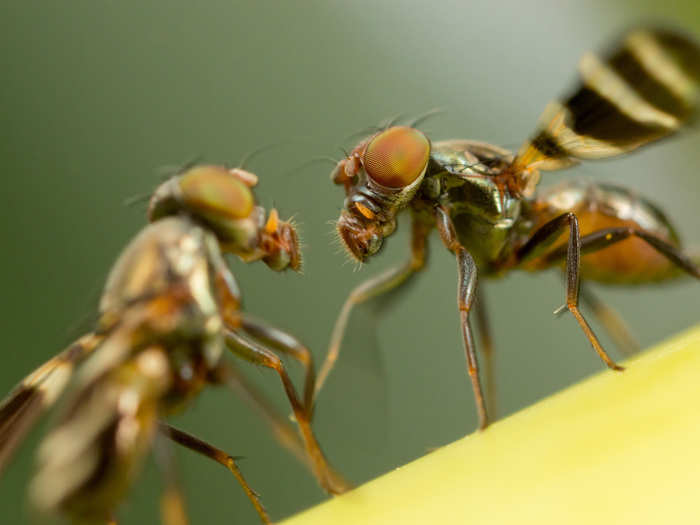
NASA still sends fruit flies to space today, in a bid to understand how space affects biology, and even human biology.
NASA admits that "to most people, fruit flies are just pests that hover around over-ripe bananas and other forgotten fruit."
But it says that studying them can "help address the effects of long-duration space missions on an astronaut's body and the way the body responds to new and stressful environments."
Around "75% of human disease genes have similar genes in the fruit fly," and it takes little equipment and few resources to keep them.

The first monkey in sent to space, Albert I, was launched in a V-2 rocket from New Mexico in June 1942, according to NASA, but he died of suffocation during the flight.
"Lack of fanfare and documentation made Albert an unsung hero of animal astronauts," according to NASA.
A second monkey, Albert II, went to space in 1948, but died on impact when returning to Earth. In total, five monkeys called Albert were sent to space. They all died.
Yorick was the first monkey to initially survive going to space in 1951, but he died a few hours after he returned — along with some of the mice he was sent up with.
The USSR also sent monkeys into space.

The first primate to survive the trip into space, and to continue to live afterwards, was Miss Baker in 1959.
Able, the other monkey sent to space with her, died after the trip on the operating table from "effects of anesthesia," but Miss Baker lived until 1984, when she died of kidney failure at aged 27.
According to Slate, NASA bought her alongside other monkeys in a Miami pet store, and Miss Baker was selected for space flight after rigorous testing to see which monkeys would be the best astronauts.
She has a grave at NASA's Space and Rocket Center in Alabama, which describes her as "the first US animal to fly in space and return alive."
America, Europe, and Russia stopped sending monkeys into space in the 1990s.

NASA says that the mouse "was not recovered alive, although pictures were made of its behavior in a weightless state."
It continued to send mice into space, a practice also carried out by nations like France and the USSR.

NASA and other space agencies are still studying mice in space.
In April 2019, NASA shared a video of weightless mice on the International Space Station as part of their study into how astronauts on longer missions are being affected in space.
NASA found that the mice were carrying out their typical behaviors — like moving around their cage, grooming, and eating — but found ways to adjust them as they were weightless.

Laika, a stray dog from Moscow, was the first dog in space, and the first animal to orbit the earth.
But her trip was one-way: there was no plan for how she would return to Earth.
"It is likely Laika only survived for a few hours after reaching orbit," according to NASA.
Adilya Kotovskaya, the Russian biologist who trained Laika for space, told Phys.org in 2017: "I asked her to forgive us and I even cried as I stroked her for the last time."
NASA said that her journey "began to galvanize the United States into organizing their space program."

The USSR used female dogs, typically strays as they were theoretically able to deal with harsher conditions.
In 1960, Belka and Strelka were the first animals to reach orbit and return safely. According to the BBC, they "appeared happy and unharmed by their experience" when they returned to Earth, and became internationally famous.
Veterok and Ugolyok, who were launched in 1966, still hold the record as being the canines who stayed the longest in space. They were in space for 22 days.
Read more: I traveled to Russia and met the first dogs to ever survive space in this rare museum

It sent two dogs and the first rabbit into space in 1959.

Ham the Chimp was sent to space in January 1961, making him the first chimpanzee in space.
He was brought from West Africa to be trained by NASA in 1959, and experienced 6.6 minutes of weightlessness on his flight.
According to NASA, he "performed well during his flight," and afterwards was "slightly fatigued and dehydrated, but in good shape otherwise."
"Ham's mission paved the way for the successful launch of America's first human astronaut, Alan B. Shepard, Jr., on May 5, 1961," NASA said.
Ham lived in two zoos until his death in 1983, and his remains were "respectfully laid to rest in front of the International Space Hall of Fame in Alamogordo, New Mexico."

The USSR sent guinea pigs into space along with a dog and some reptiles in 1961, and all survived the trip.
Read more: An Apollo astronaut explains how he nearly killed himself 'horsing around' on the moon in 1972

Félicette went to space in 1963 and experienced weightlessness and was successfully recovered. But a later flight with another cat had difficulties.
Félicette was ultimately the only cat to make it to space, even though others were trained.
A 2017 Kickstarter campaign to build a statue for her in Paris exceeded its goal, with the fundraisers saying that she was overlooked compared to other animals who made the trip into space.
The campaign said that "very few people are aware that a cat went to space at all" and that it was "time for The Astrocat to get the memorial she rightly deserves."
The statue hasn't yet been built, but remains in the works.

A USSR probe carrying tortoises, meal worms, wine flies, and seeds flew around the moon in 1968.
The flight was a week long, The Associated Press reported at the time, and the tortoises came back around 10% lighter but with "good appetites."

According to NASA, once humans landed on the moon, "animals no longer made the front page."
It said that "rabbits, turtles, insects, spiders, fish, jellyfish, amoebae, and algae" were sent into space to test "long-range health effects in space, tissue development, and mating in a zero-g environment."
But two spiders, Anita and Arabella, who went to space in 1973 grabbed headlines for managing to successfully spin webs in space.
According to NASA, the experiment "proved that spiders could still spin webs in microgravity." This in turn proved that they were able to adapt to the new environment.
Spiders typically sense their "own weight to determine the required thickness of web material and uses both the wind and gravity to initiate construction of its web," NASA said.

NASA bred jellyfish in space and brought their babies back to Earth in the 1990s to see how they would adjust to gravity.
The baby jellyfish did not adjust well. A 1994 study found that they struggled to move around and orient themselves.

NASA has sent different types of fish to the International Space Station in a bid to study how microgravity affects them.
They sent zebrafish in 2015 to see how weightlessness affects their muscles, which NASA said had the "potential to lead to new drugs or treatments for patients on extended bed rest or with limited mobility."
And medaka fish, a type of freshwater fish, were sent in 2012 to see how their skeletal system was affected — though most died in the first few months.
Among NASA's findings are the fact that "fish and tadpoles swim in loops, rather than straight lines, because there is no up or down to orient them" when they lost gravity, and "if a light shines, the fish use that as their guide source and swim towards the light."
 I spent 2 weeks in India. A highlight was visiting a small mountain town so beautiful it didn't seem real.
I spent 2 weeks in India. A highlight was visiting a small mountain town so beautiful it didn't seem real.  I quit McKinsey after 1.5 years. I was making over $200k but my mental health was shattered.
I quit McKinsey after 1.5 years. I was making over $200k but my mental health was shattered. Some Tesla factory workers realized they were laid off when security scanned their badges and sent them back on shuttles, sources say
Some Tesla factory workers realized they were laid off when security scanned their badges and sent them back on shuttles, sources say Top places to visit in Auli in 2024
Top places to visit in Auli in 2024
 Sustainable Transportation Alternatives
Sustainable Transportation Alternatives
 Why are so many elite coaches moving to Western countries?
Why are so many elite coaches moving to Western countries?

Copyright © 2024. Times Internet Limited. All rights reserved.For reprint rights. Times Syndication Service.